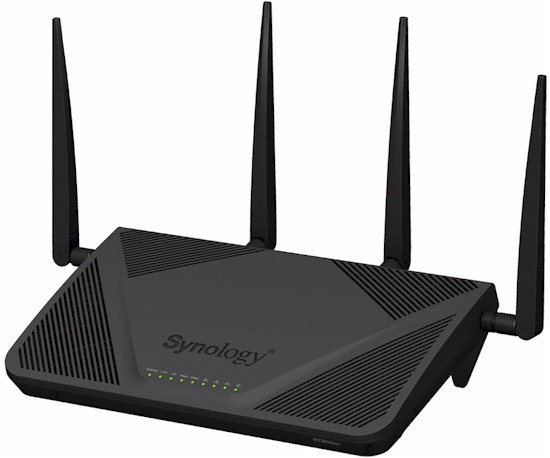
| At a glance | |
|---|---|
| Product | Synology AC2600 Router (RT2600ac) [Website] |
| Summary | Qualcomm-based AC2600 class app-based router with Gigabit Ethernet ports, USB 2.0 / 3.0 storage and printer sharing and MU-MIMO support. |
| Pros | • Features expandable via add-in apps • Good Wi-Fi performance • Supports some DFS channels • MU-MIMO works well |
| Cons | • No Wireless bridge support • Still a relative newcomer to a highly competitive market |
Typical Price: $179 Buy From Amazon
Introduction
Update 2/10/17 – Various Wi-Fi feature updates
Synology apparently thinks the Wi-Fi router market is worth pursuing, because it’s back with more grist for the mill. This time, it’s a Qualcomm-based 4×4 MU-MIMO enabled model dubbed the RT2600ac.
The RT2600ac is very much like its RT1900ac predecessor we reviewed last March in both form and function. Both have a fingerprint-resistant black matte “vapor blast” finish. The RT2600ac appears to have better ventilation with plenty of slots on top and bottom. Its front panel LEDs have been moved to the top of the router vs. the RT1900ac’s front edge.
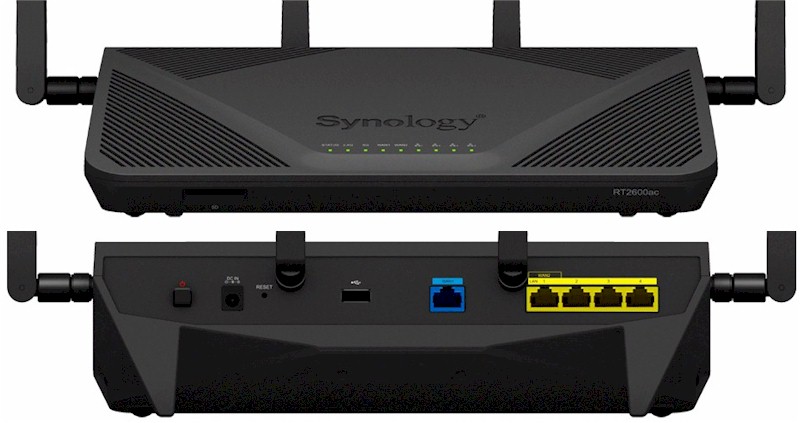
Synology RT2600ac front and rear
The RT2600ac’s back end is elevated by two legs molded into its bottom cover. Although there are wall-mount screw slots also molded into the bottom, you won’t be able to actually wall mount it without sawing off the plastic legs. Synology also dispensed with the bracket included with the RT1900ac that stands it up almost vertically.
Synology’s main attempt at standing out among the multitude of Wi-Fi routers competing for your wallet is the SRM OS that gives this hunk of plastic and silicon life. SRM has the look and feel of Synology’s DSM NAS operating system and can be enhanced by installing add-on packages.
The image below shows the front and rear panel callouts. Note the Ethernet WAN and LAN ports don’t have link / activity LEDs. There are both USB 2.0 and 3.0 ports (the RT1900ac has only USB 3.0) and the SD card reader has been carried over from the RT1900ac. The four dual-band antennas are attached via RP-SMA connectors.
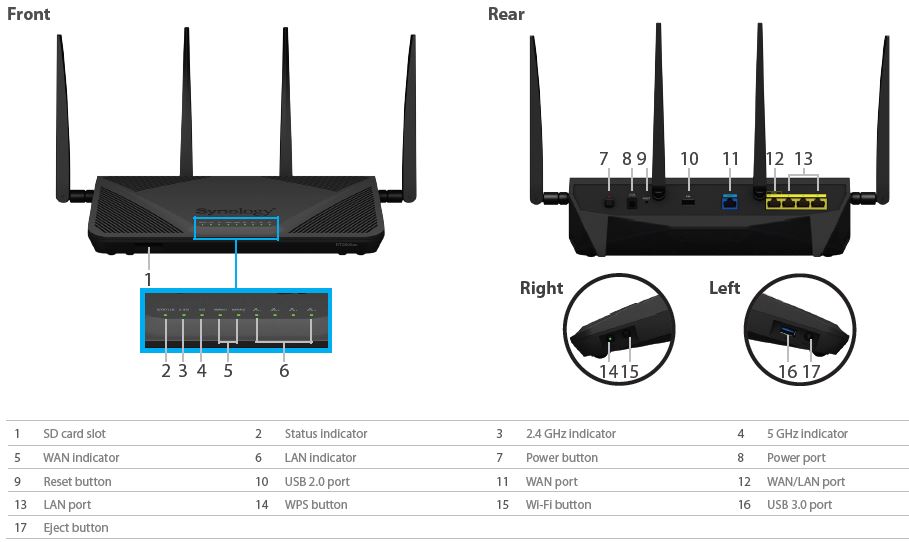
Synology RT2600ac callouts
Inside
I didn’t have to open the RT2600ac after testing because its FCC ID internal pictures were available. As expected from its AC2600 classification, the router is a Qualcomm-based design vs. the RT1900ac’s Broadcom-based platform.
The first photo shows the router with top cover removed, revealing a aluminum heat spreader plate that runs the width of the router. A similar plate also spans the other side of the board. Both are thermally coupled to hot spots via silicone pads.
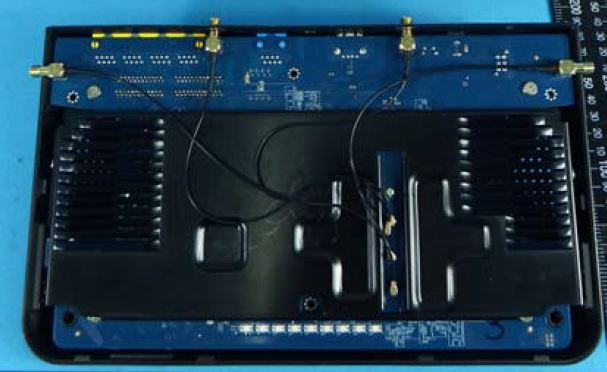
Synology RT2600ac inside
Removing the plate shows nothing much on this side of the board except the 4 GB Toshiba eMMC at photo left. The light areas at photo center and right are thermal pads to couple top-side components to this board side’s heat spreader.
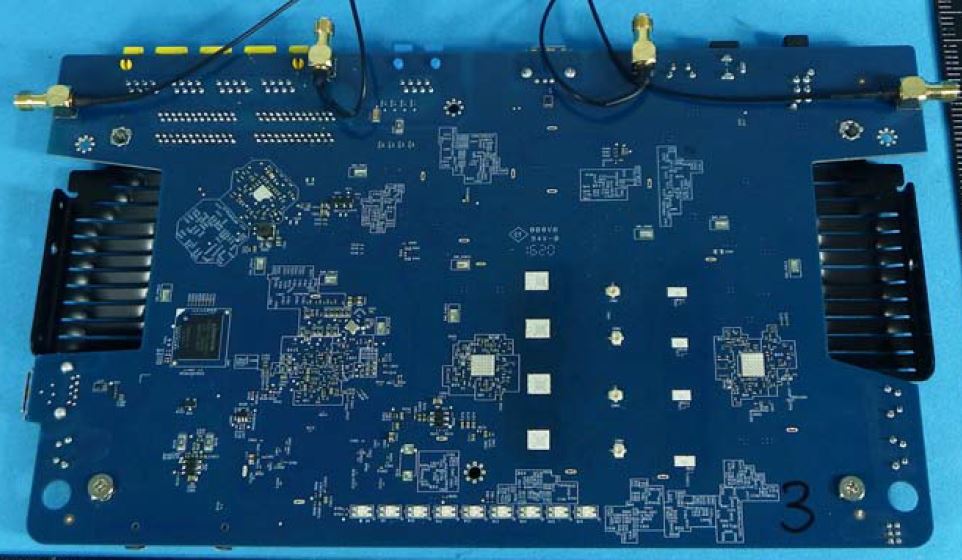
Synology RT2600ac board bottom
The other side of the board, shown with heat spreader plate and RF can tops removed, holds most of the components. The Qualcomm IPQ8065 quad-core network processor and 512 MB DDR3 RAM is in the right-most can, with 5 GHz radio in the center and 2.4 GHz on the left.
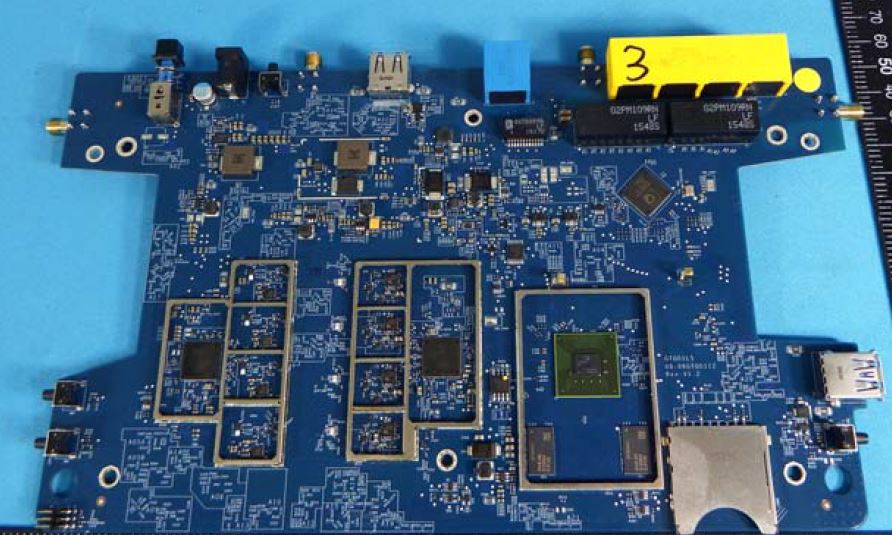
Synology RT2600ac board top
Update 2/10/17
Key components for both Synology routers are shown in Table 1 along with NETGEAR’s R7800. The R7800 and RT2600ac’s components are virtually identical, but the RT2600ac’s spec doesn’t mention including 160 MHz bandwidth support, not that it matters. That’s fine with me; 160 MHz support is just another shiny thing router makers are dangling in front of naive buyers to spur sales. It only benefits devices that also support it, and there aren’t any of those yet, at least not in devices most of us own.
| Synology RT2600ac | NETGEAR R7800 | Synology RT1900ac | |
|---|---|---|---|
| CPU | Qualcomm IPQ8065 quad-core network processor @ 1.7 GHz | Qualcomm quad-core IPQ8065 Internet Processor @ 1.7 GHz | Broadcom BCM58622 @ 1 GHz |
| Switch | QCA8337 | Qualcomm Atheros QCA8337 | In BCM58622 |
| RAM | 512 MB | 512 MB | 256 MB |
| Flash | 4 GB / 8 MB | 128 MB | 4 GB / 1 MB |
| 2.4 GHz Radio | – QCA9984 4×4 Wave-2 802.11ac – Skyworks SE2623L 2.4 GHz Power Amp (x4) |
– QCA9984 4×4 MU-MIMO 802.11ac radio – Skyworks SE2623L 2.4 GHz power amp (x4) |
– Broadcom BCM43460 – Skyworks SE2623L 2.4 GHz Power Amp (x3) – Skyworks SKY13377 6 GHz SPDT switch (x3) – Skyworks SKY15971 2.4 GHz LNA (x3) |
| 5 GHz radio | – QCA9984 4×4 Wave-2 802.11ac – RFMD PA5542 5 GHz power amp (x4) |
– QCA9984 4×4 MU-MIMO 802.11ac radio – RFMD RFPA5542 5 GHz PA module (x4) |
– Broadcom BCM43460 – RFMD RFFM4552 5 GHz front end (x3) |
Table 1: Component summary
Features
As mentioned earlier, the RT2600ac runs Synology’s SRM router OS. Craig’s RT1900ac review does a good job detailing SRM features, so go there if you want a rundown. SRM has now advanced to V1.1.3 (for both routers), bringing new features to both routers.
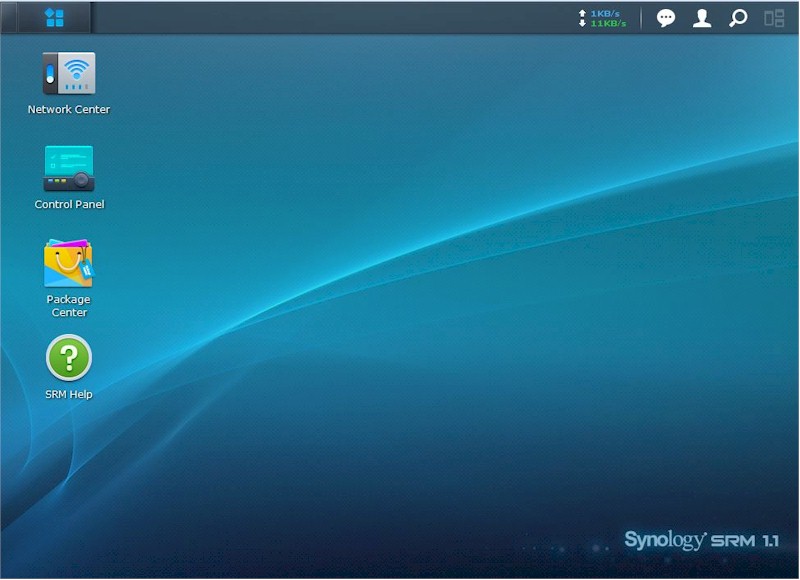
Synology RT2600ac landing page
Synology provided the following summary of new features in SRM 1.1:
- Smart Connect: 2.4 / 5 GHz band steering, customizable by signal strength, load balancing or both.
- Smart WAN: Designate a secondary WAN interface and set up automatic network failover or load balancing. Customizable routing policies also make it possible to route traffic through a specific interface according to the destination or source address.
- Application Layer or Layer 7, Quality of Service control shows the bandwidth consumed by individual applications and devices. Restrict the amount of bandwidth for specific applications, without affecting the rest, and generate traffic usage reports sorted by application and device.
- Intrusion Prevention (Beta): With the intrusion detection system (IDS) and intrusion prevention system (IPS), SRM 1.1 can analyze network traffic in order to detect or detect and block malicious packets and requests from entering the user’s local network.
- Content filtering: Parental control and traffic filtering now includes Google SafeSearch integration and the ability to add three customizable profiles to fine-tune and block access.
- File syncing and backup: SRM 1.1 supports running Synology’s Cloud Station Suite, allowing users to sync files to computers with Cloud Station Drive or back up files from Windows, MacOS, and Linux computers in real time with Cloud Station Backup.
The Intrusion Protection feature bulleted above is one of the two add-on packages that are new to SRM 1.1. The other is the VPN Plus server shown at the top of the Package Center screenshot below. Both are Beta versions and add significant features to the SRM OS.
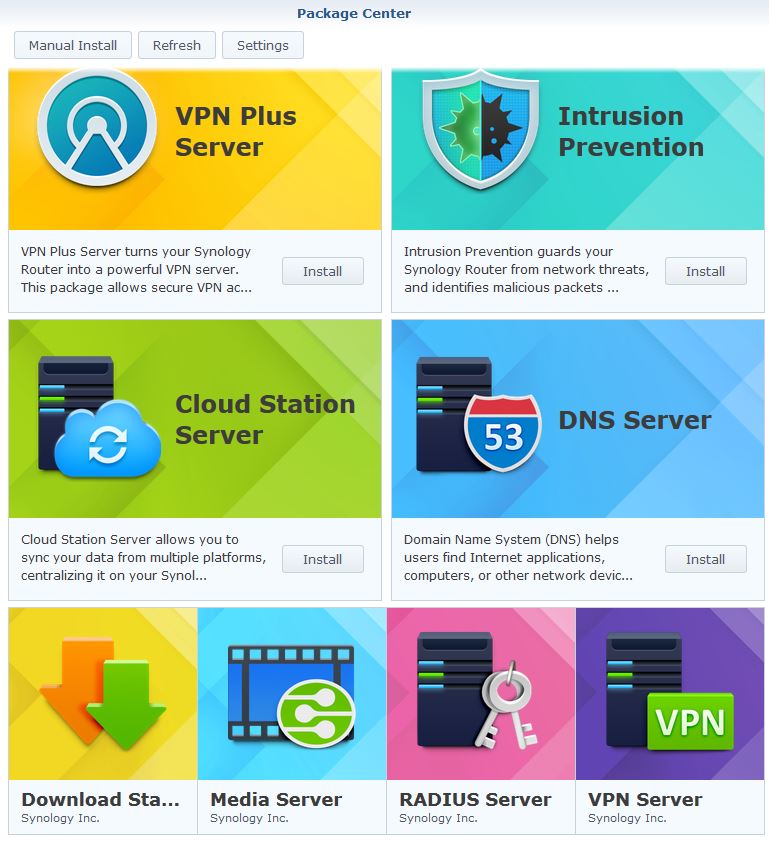
Synology RT2600ac Package Center
Intrusion Protection is said to add intrusion detection system (IDS) and intrusion prevention system (IPS) features. You need to connect USB storage before you can install the package. I threw a 2 GB flash drive on, which was enough to allow installation. The package automatically allocated 500 MB of storage for logs. Synology doesn’t officially specify a minimum storage value for the Intrusion Protection package, but estimated it was probably around 256 MB. However, this wouldn’t allow storage of many (if any) logs.
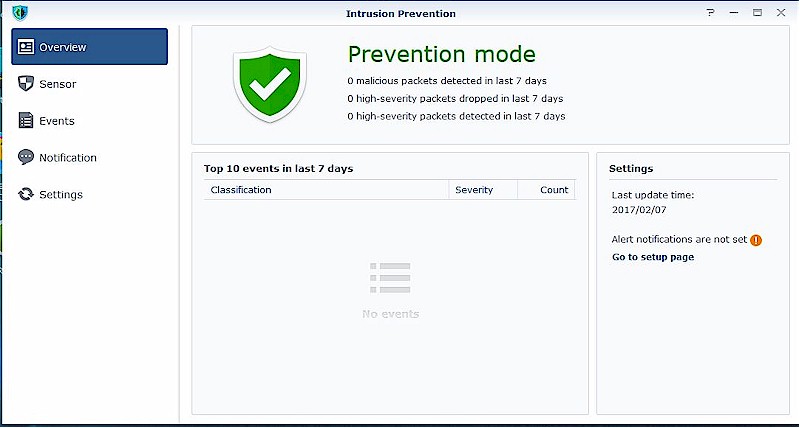
Intrusion Protection add-on package
IPS appears to use proofpoint’s ET Open ruleset by default, with the option to move up to the ET Open Pro ruleset, for an unspecified price.
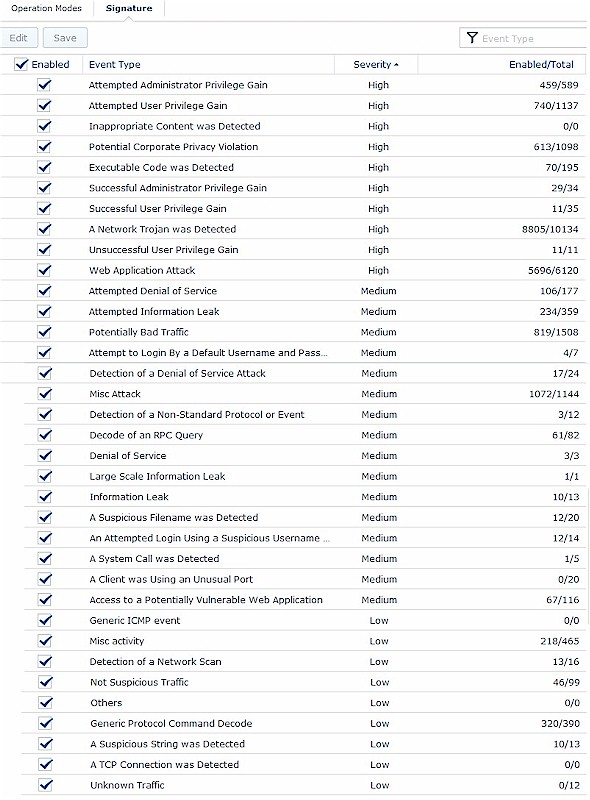
Intrusion Protection signatures
I ran a quick internet speed test with Intrusion Protection enabled and it didn’t appear to affect my 10 / 1 DSL connection at all, which I realize isn’t saying much. Synology’s reviewer’s guide said its internal tests clocked SSL VPN bidirectional throughput at 103 Mbps and OpenVPN at 53 Mbps, but didn’t spec WAN / LAN throughput with IPS enabled.
VPN Plus expands secure connection options beyond the PPTP, Open VPN and L2TP/IPsec options in the original VPN Server add-on, which is still available, but now marked as a "legacy" package. VPN Plus adds licensed Synology SSL VPN, clientless WebVPN and SSTP options to the non-licensed PPTP, OpenVPN and L2TP/IPsec options supported in the original VPN server add-on. One license is included for the new VPN servers, with the ability to purchase more licenses coming later.
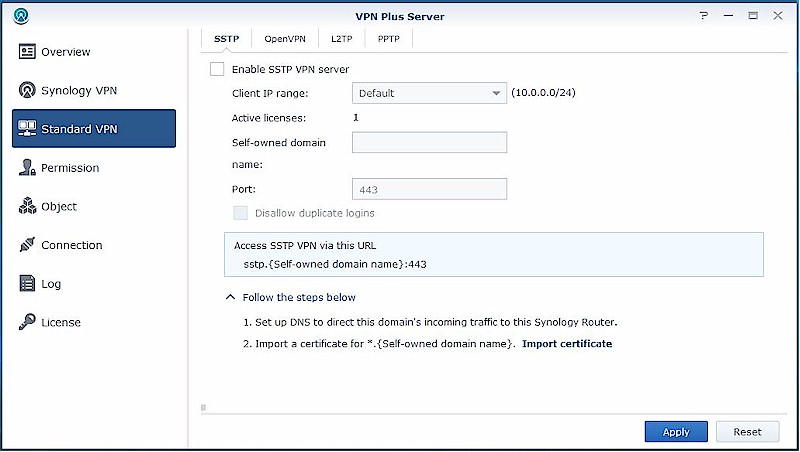
Intrusion Protection add-on package
Wireless Features
Update 2/10/17
While we’re reviewing features, let’s take a quick look at Wireless controls. WPS is supported and enabled for PIN and push button methods by default, but can be disabled. Although it’s not a wireless feature, but is of interest for security, UPnP is also enabled by default, but can also be disabled. A list of devices and ports opened by UPnP is also available.
As mentioned above, Smart Connect aka band steering is supported and can be tweaked by signal strength, load balancing or both as shown below.
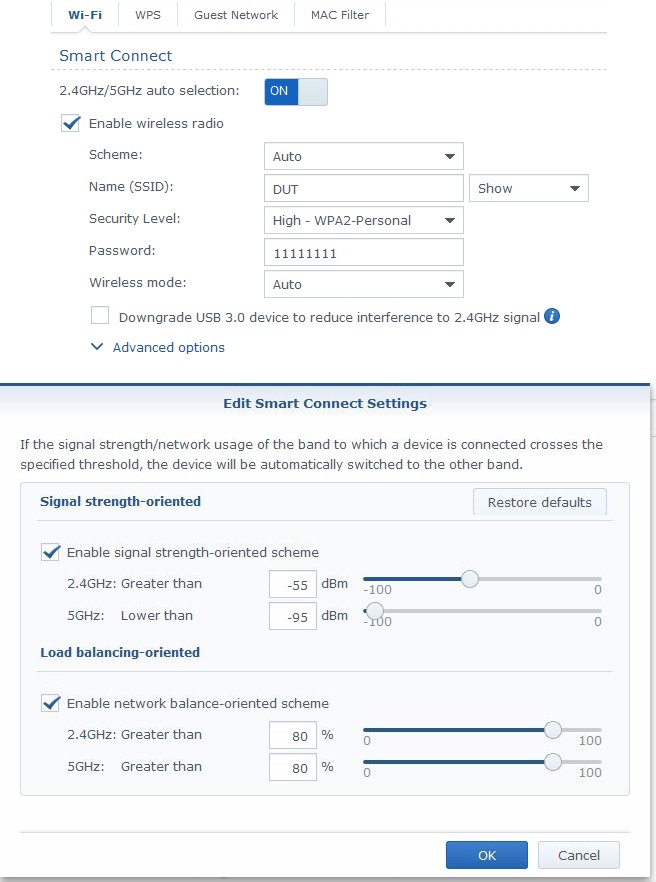
Smart Connect settings
A guest network can be enabled for each band. Each has controls for wireless security, enable time, AP isolation (prevents clients from communicating with each other) and local network access. Wireless controls for each band are shown below. Some settings shown have been changed from the defaults, which set channel to Auto. Transmit power options are high / medium / low and WPA/WPA2 Enterprise options are also supported. Some 5 GHz DFS channels are supported, too (52,56,60,64,100,104,108,112), but channel 165 is not when channel width is set to 20/40/80 MHz. If you set this selector to 20 MHz, you’ll see channel 165.
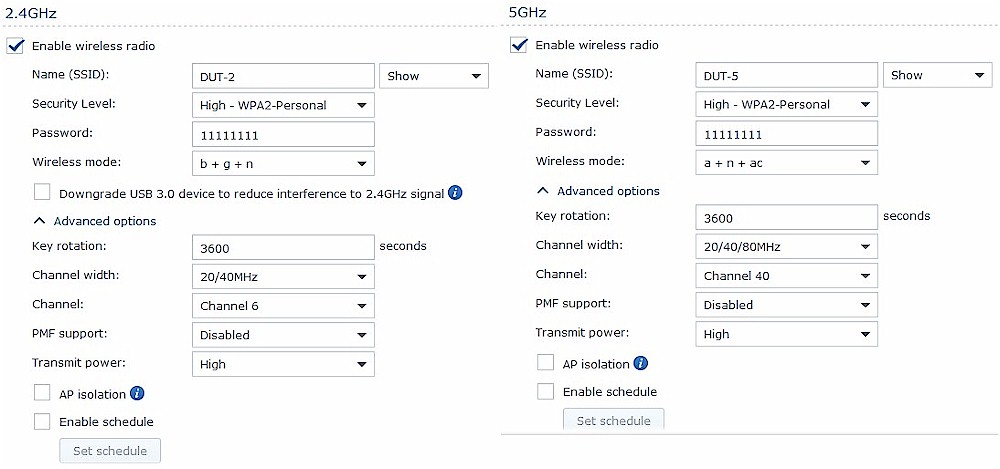
Wi-Fi settings
The only glaring omission is support for wireless bridging (Synology says is will add support for WDS bridging "later this year"). But the router can be set to AP mode.
Storage Performance
The summary graphic below from the Router Charts shows write and read storage performance for USB 3.0 connection and NTFS format for the top 10 products tested with the latest Version 9 process. The RT2600ac was at the bottom of the group at 40 MB/s write, but in the #5 spot for read with 90 MB/s. USB 3.0 / FAT32 performance measured 43 MB/s write and 105 MB/s read.
Note you need reach the Router’s share using \\192.168.1.1; you can’t browse to it using Windows’ network browser. Guest (no login) access didn’t work, so the admin account was used to test storage performance. The media server wasn’t running during the performance test.
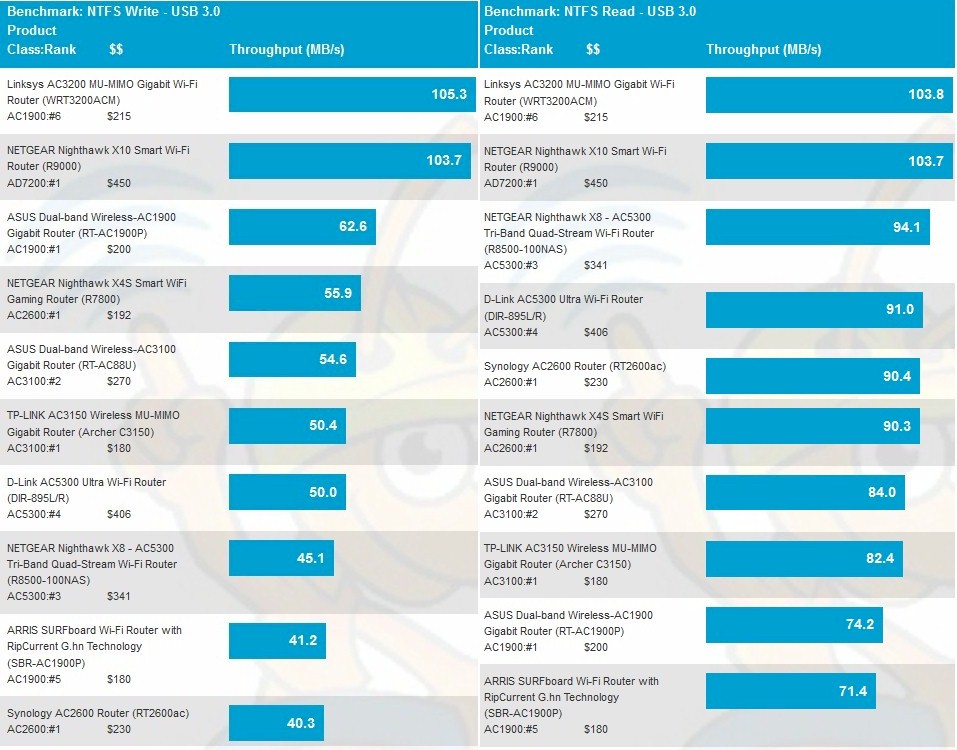
Storage Performance Comparison – USB 3.0 / NTFS
Routing Performance
Routing throughput was measured using the V4 router process with the router loaded with SRM 1.1.3-6447 Update 2 firmware. Table 2 summarizes the results: this Excel test summary contains all functional and performance test results. The NETGEAR R7800 is included for comparison because of its very similar hardware design.
Both routers have essentially identical TCP/IP routing performance, maxing out our measurement ability. The Synology scored slightly higher on the functional test but had one serious test failure, i.e. one of the firewall tests found port 80 open to the WAN side.
| Test Description | Synology RT2600ac | NETGEAR R7800 |
|---|---|---|
| WAN – LAN Throughput – (Mbps) | 941 | 941 |
| LAN – WAN Throughput – (Mbps) | 941 | 941 |
| Total Simultaneous Throughput – (Mbps) | 1844 | 1822 |
| Functional Score | 89.8 | 87.8 |
| Firmware Version | SRM 1.1.3-6447 Update 2 | V1.0.2.04 |
Table 2: Routing throughput
Wireless Performance
The Synology RT2600ac is Wi-Fi certified. It was tested with the V9 wireless test process with SRM 1.1.3-6447 Update 2 version firmware loaded. Channel 6 and 20 MHz B/W mode was set for 2.4 GHz and Channel 40 and 80 MHz B/W mode was set for 5 GHz. The router was positioned in the test chamber as shown in the photo below. I’ll be comparing performance to three other 4×4 routers tested with the V9 process: NETGEAR R7800; TP-Link Archer C3150 and ASUS RT-AC88U.
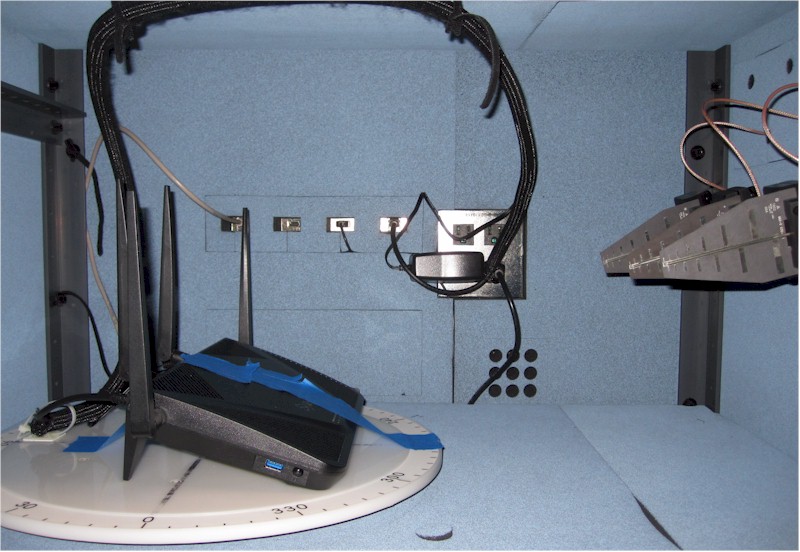
Synology RT2600ac in test chamber
Comparing average 2.4 GHz throughput for the selected routers tested shows the RT2600ac essentially tied with the TP-Link with 78 Mbps average throughput on downlink, but 71 Mbps on uplink; a 10 Mbps average throughput lead.
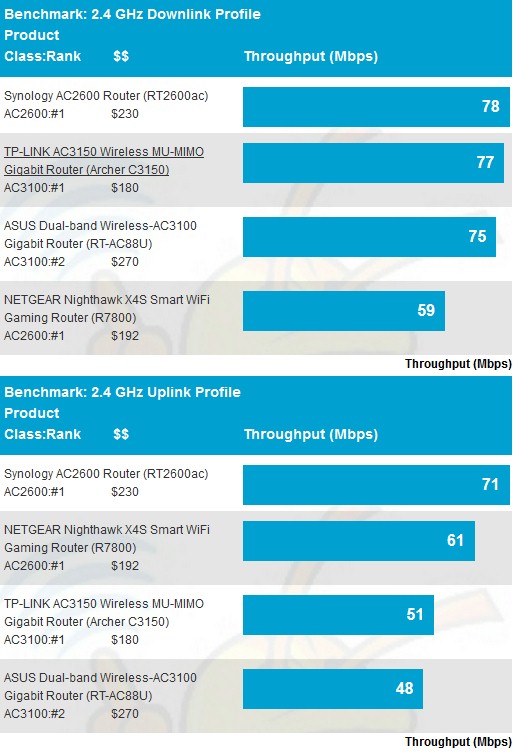
2.4 GHz average throughput comparison
Comparing average 5 GHz throughput shows the RT2600ac not faring as well, coming in last on downlink with 241 Mbps average throughput and next to last with 203 Mbps on uplink.
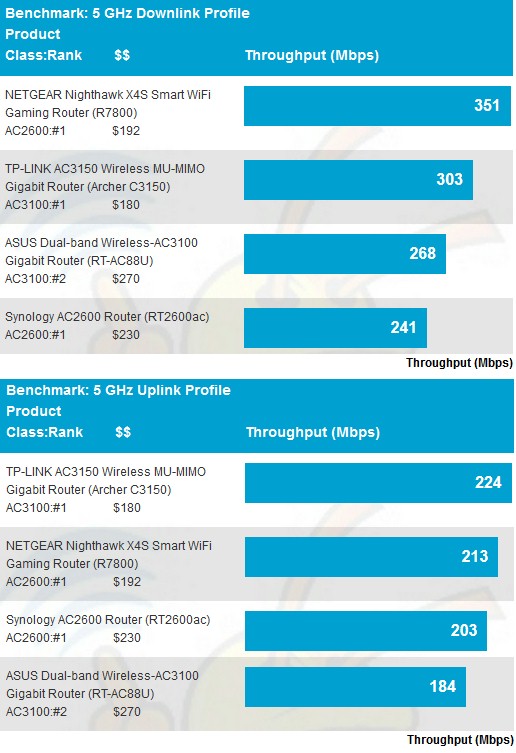
5 GHz average throughput comparison
Moving on to throughput vs. attenuation plots, for 2.4 GHz downlink, the RT2600 does very well, tracking the ASUS and TP-Link for most of the run. It also ends the run with higher throughput than the three other products.
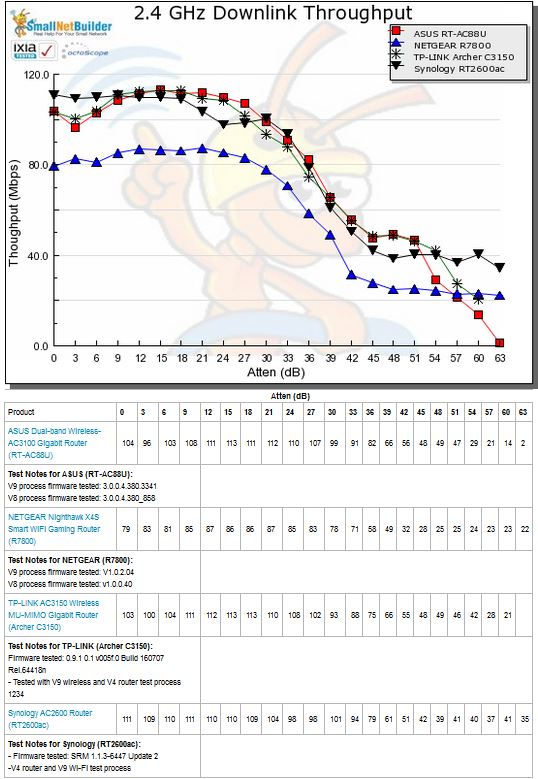
2.4 GHz Downlink Throughput vs. Attenuation
For 2.4 GHz uplink, the RT2600ac maintains the highest throughput throughout its entire run. The only minor negative is that it disconnected before running the 63 dB test.
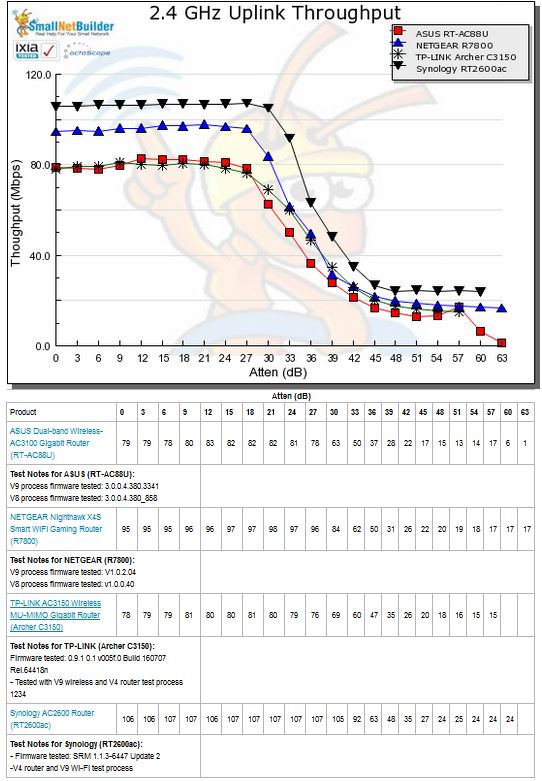
2.4 GHz Uplink Throughput vs. Attenuation
5 GHz downlink is a tougher call. The Synology starts out slightly below the NETGEAR, but above the ASUS and TP-Link. But the RT2600ac’s throughput starts trending downward almost immediately and dropping below the other three routers from 12 dB onward. It recovers only slightly at the last two tests in the run. I can’t explain the NETGEAR R7800’s odd curve shape, but it’s definitely there and definitely repeatable.
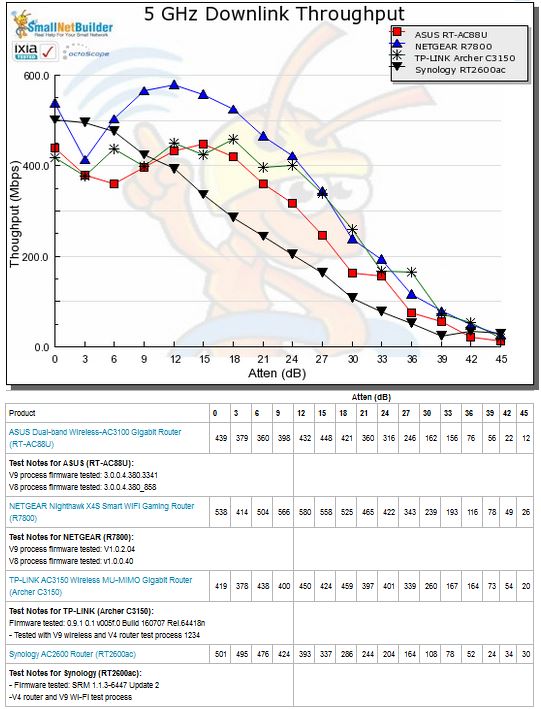
5 GHz Downlink Throughput vs. Attenuation
5 GHz uplink shows all products in a fairly narrow range. For all intents and purposes, all three are equal for this benchmark.
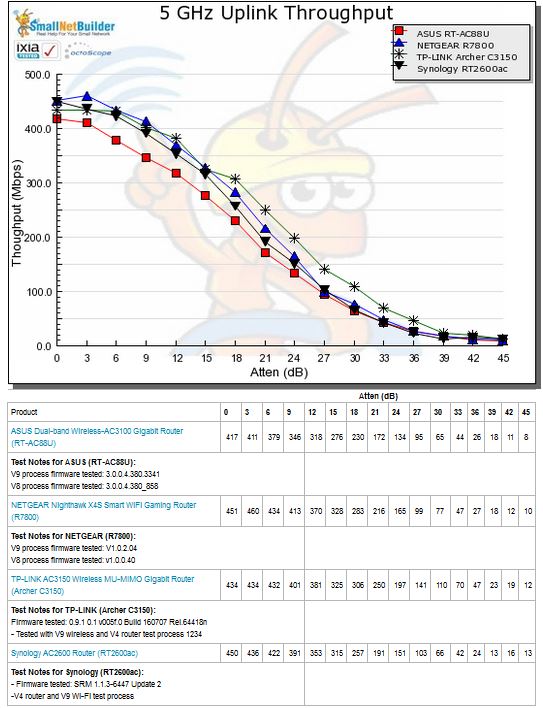
5 GHz Uplink Throughput vs. Attenuation
The takeaway for me is that the RT2600ac’s performance is more in line with other 4×4 routers than the RT1900ac was for other 3×3 products. Unfortunately, its performance is weakest where you would want it to be strongest—5 GHz downlink.![]()
Maximum Wireless Throughput
Since throughput vs. attenuation plots are now done with a 2×2 STA, we use the Ixia Veriwave that can emulate up to 4×4 ac devices. The results posted are an average of 10 one minute test runs. This benchmark is fully described in the Revision 9 test process description. We’re again comparing the same four 4×4 AC routers.
2.4 GHz results show all four products with very similar performance, but in two groups. It’s interesting that the NETGEAR and Synology are in the lower group for downlink, but upper group for uplink.
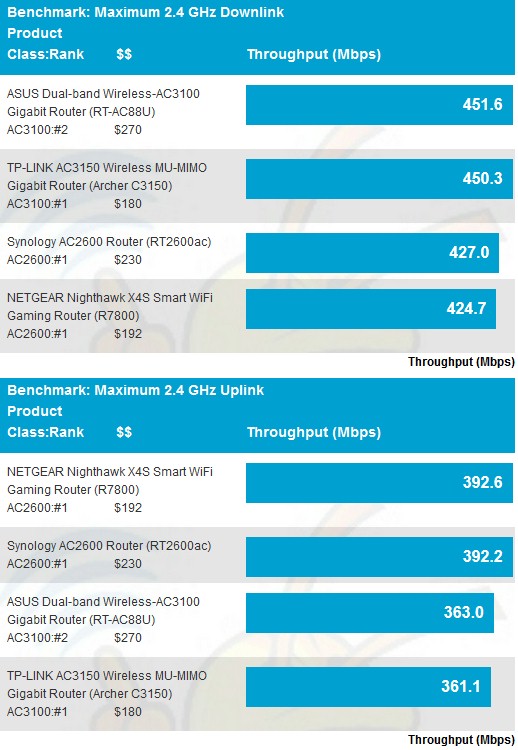
Maximum Wireless Throughput comparison – 2.4 GHz
5 GHz maximum throughput shows more of a performance spread in both directions. The Synology has the lowest 4×4 throughput with 851 Mbps for downlink, but the highest for uplink at 876 Mbps.
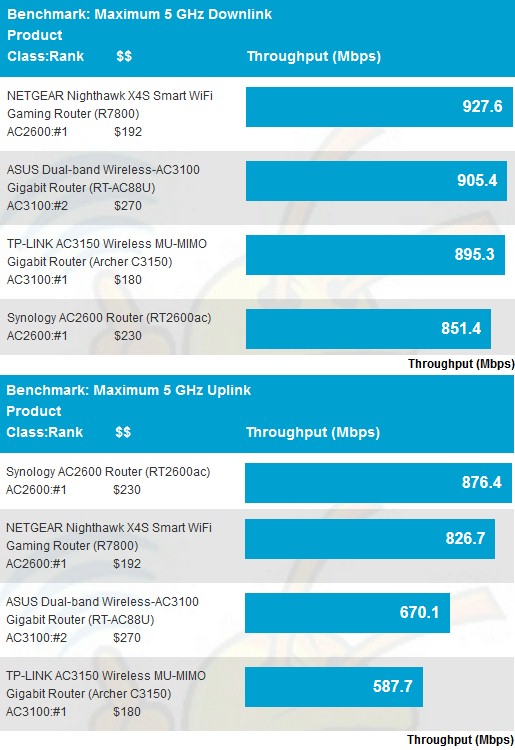
Maximum Wireless Throughput comparison – 5 GHz
I often find that products will not run this test at maximum MCS (link) rates. But the Synology did, connecting at VHT (802.11ac) MCS9 for 5 GHz and HT (802.11n) MCS31 for 2.4 GHz.
MU-MIMO
Seems like it’s been forever since I’ve run the Veriwave MU-MIMO throughput tests. Either products were Broadcom based, which have yet to run well with the Veriwave setup, or they didn’t have connectorized antennas, like NETGEAR’s R9000. At any rate, the RT2600ac set up easily and ran our MU-MIMO scaling benchmark without muss or fuss. If you need a refresher on our MU-MIMO test method, it’s described here.
The first bar chart shows average MU-MIMO throughput for 1 to 16 STAs for the Synology, NETGEAR R7800 and Linksys EA9500. The NETGEAR has the highest average throughput, but the Synology doesn’t too too badly at 493 Mbps, which is closer to the NETGEAR’s 580 Mbps than the Linksys’ 319.
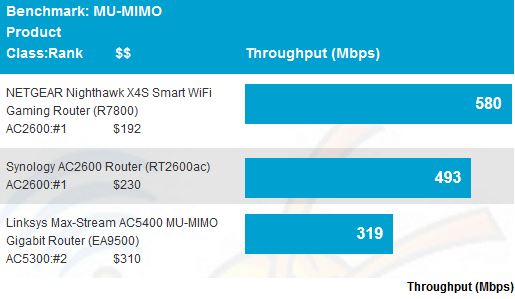
MU-MIMO Average Throughput comparison
SU (single user) MIMO tests show how efficent routers are at serving multiple STAs. Ideally, total throughput should be divided among active STAs, with none lost. This benchmark is also good for showing MU-MIMO routers that are likely to misbehave when dealing with multiple non MU-MIMO clients. All three routers do pretty well in this test.
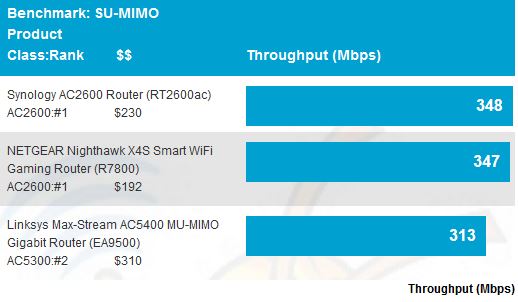
SU-MIMO Average Throughput comparison
The MU, SU Throughput Difference shows how much total throughput gain is achieved using MU-MIMO. The NETGEAR does the best, Linksys the worst and the Synology at 145 Mbps closer to the NETGEAR at 233 Mbps than to the Linksys at 6 Mbps.
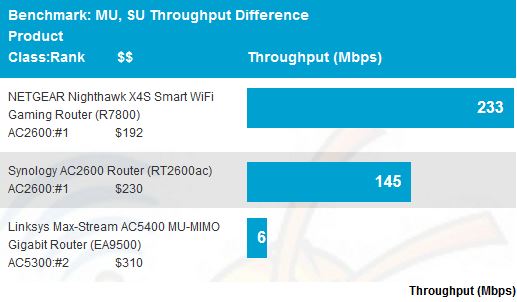
Average MU, SU Throughput difference
Plotting the MU,SU Difference shows both the NETGEAR and Synology MU gain peaking at 3 STAs—as it should—then declining as more STAs are added. Linksys MU-MIMO gain also peaks at 3 STAs, but with much lower total throughput gain. Like the NETGEAR R7800, the RT2600ac is another example of a MU-MIMO router likely to do what it is supposed to do if you connect multiple MU-MIMO devices,.
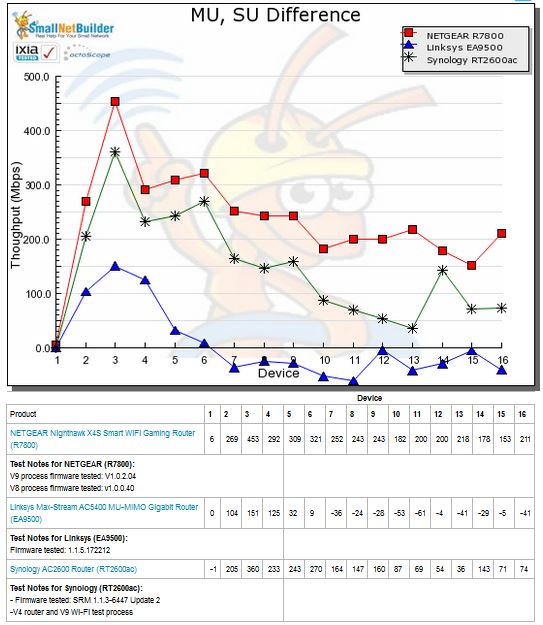
MU, SU Throughput difference
Read this if you’d like an explanation of what happens with more than 3 MU-MIMO STAs.
Closing Thoughts
We have only two AC2600 class routers tested with the V9 process, the NETGEAR R7800 and Synology RT2600ac. Nonetheless, I’m sure Synology will be happy to see the RT2600ac tied with the NETGEAR for #1 rank in AC2600 routers.

The Ranker Performance Summary comparison of the two routers shows some of the sub-rankings the same, but the differences balanced out to yield the same #1 rank score.
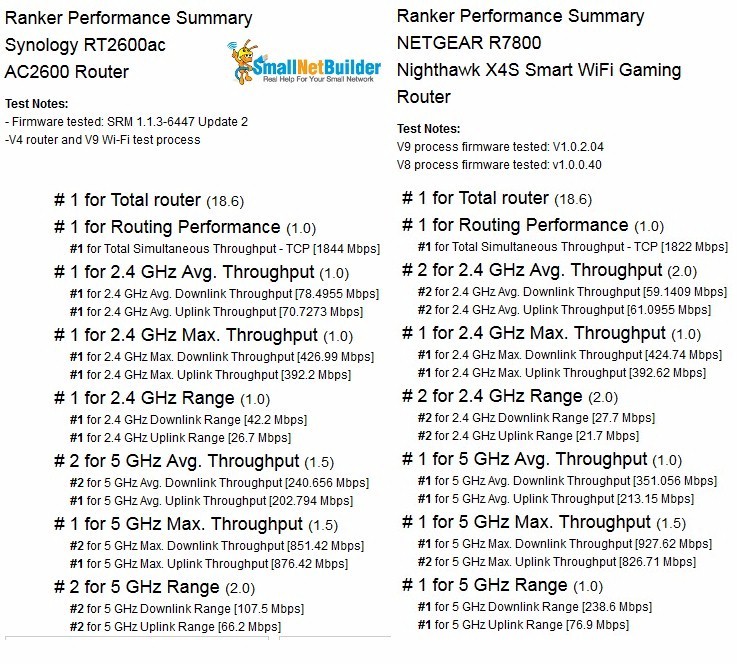
Ranker Performance Summary comparison
Our RT1900ac review concluded that it had a nice feature set that could be enhanced by a relatively small set of add-on packages. But its performance didn’t stack up well against other products in its class for wireless performance.
However, instead of admitting defeat and leaving the highly-competitive Wi-Fi router market, Synology dug in and came up with a much better product in the RT2600ac. Synology not only improved performance, but also expanded features in areas near and dear to router geeks’ hearts. And despite the change in processor platforms from Broadcom to Qualcomm, Synology showed its commitment to its installed base by bringing the new features to both platforms.
Although the RT2600ac is Synology’s best router yet, it’s only the company’s second offering in an industry with both well-established competitors and innovative newcomers. While the RT2600ac is an achievement to be proud of, the company still has a long way to go to show it is in Wi-Fi for the long haul. Bigger storage companies have taken a run at the Wi-Fi router market, WD most notably, and decided it was more of a distraction than an asset. Time will tell whether Synology reaches the same conclusion.
